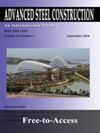A performance evaluation of the arch bridge members using the strain index based on the parameters obtained from linear buckling theory
IF 1.7
3区 工程技术
Q3 CONSTRUCTION & BUILDING TECHNOLOGY
引用次数: 0
Abstract
To develop a seismic performance evaluation method based on the strain demand control of some critical parts when the arch bridges are subjected to the strong ground motions, it is necessary to establish the method to determine the ultimate strain of each segment (defined as the limit of the strain) which has reached the corresponding critical stress. In this study, the empirical formulas of the ultimate strain corresponding to the failure criterions by in-plane buckling and out-of-plane buckling are investigated and proposed emphasized on the stiffened box-section with longitudinal stiffeners. The applicability of box-cross sections with the longitudinal stiffeners and concrete filled is also been brought into one of the ideas to strengthen the arch bridge where the plasticization are formed in some segments due to the strong ground motion. To perform the analyses, the aspect ratio of the arch member which the lowest maximum strength may be expected was determined beforehand by considering the parameters obtained from linear buckling theory. Then the bending analyses under various axial load ratio parameters were examined to clarify the effect of failure segments in both stiffened sections with and without concrete filled models by the FEM analyses. The post buckling behaviors of concrete filled sections were also observed and compared to the stiffened box-cross sections for each width-to-thickness ratio parameter. Based on the numerical results of the stiffened sections with and without concrete filled models, empirical formulas of the ultimate strain were proposed in functions of width-to-thickness ratio parameter and axial load ratio parameter.基于线性屈曲理论参数的应变指数对拱桥构件进行了性能评价
为了建立一种基于关键部位应变需求控制的拱桥在强地震动作用下的抗震性能评价方法,需要建立确定达到相应临界应力的各部分极限应变(定义为应变极限)的方法。本文着重研究了纵向加筋箱形截面的面内屈曲和面外屈曲破坏准则所对应的极限应变经验公式。在强地震动作用下,部分拱段出现塑化现象,提出了纵向加劲和填充混凝土的箱形截面加固的思路之一。考虑线性屈曲理论得到的参数,事先确定了最大强度最低的拱构件的展弦比。然后对不同轴向载荷比参数下的加筋截面进行了弯曲分析,通过有限元分析阐明了加筋和不加筋对加筋截面破坏段的影响。还观察了混凝土填充截面的后屈曲行为,并将其与加劲箱形截面进行了各宽厚比参数的比较。根据加筋截面加筋模型和不加筋模型的数值计算结果,提出了加筋截面极限应变随宽厚比参数和轴向载荷比参数变化的经验公式。
本文章由计算机程序翻译,如有差异,请以英文原文为准。
求助全文
约1分钟内获得全文
求助全文
来源期刊

Advanced Steel Construction
CONSTRUCTION & BUILDING TECHNOLOGY-ENGINEERING, CIVIL
CiteScore
2.60
自引率
29.40%
发文量
0
审稿时长
6 months
期刊介绍:
The International Journal of Advanced Steel Construction provides a platform for the publication and rapid dissemination of original and up-to-date research and technological developments in steel construction, design and analysis. Scope of research papers published in this journal includes but is not limited to theoretical and experimental research on elements, assemblages, systems, material, design philosophy and codification, standards, fabrication, projects of innovative nature and computer techniques. The journal is specifically tailored to channel the exchange of technological know-how between researchers and practitioners. Contributions from all aspects related to the recent developments of advanced steel construction are welcome.
 求助内容:
求助内容: 应助结果提醒方式:
应助结果提醒方式:


